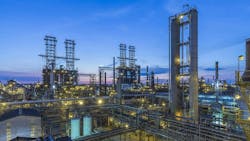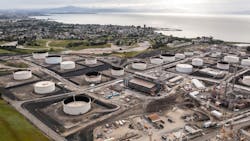Phillips 66 weighs renewable fuels projects for US refineries
The current geopolitical climate has many US refiners backtracking or otherwise remaining silent on previous commitments to expand production of renewable fuels as part of their net-zero strategies to ensure long-term operational competitiveness in a low-carbon future. Phillips 66 Co., however, is maintaining a balanced approach to meeting ongoing demand for conventional fuels while eyeing additional opportunities to grow its renewables-based portfolio for an evolving consumer market.
In midyear 2024, Phillips 66 completed the full-scale conversion of one of its two California conventional refineries into a manufacturing hub exclusively dedicated to production of renewable fuels. The company has since revealed a series of new projects under consideration during first-half 2025 that, if approved, could result in future renewables-based supplies from other US refineries within its system currently configured to exclusively process crude oil.
Alongside providing an overview of the company’s recently proposed trio of US renewables projects, this article also discusses Phillip 66’s ongoing evaluation of future uses for its soon-to-be-shuttered 138,700-b/d dual-sited refinery in Los Angeles, Calif., which potentially includes its conversion to renewables fuels production.
Potential US projects
In a series of separate late-February 2025 filings, Phillips 66 notified the US Department of Commerce’s Foreign-Trade Zone (FTZ) Board of its intent to produce a mix of renewable fuels at three of its US conventional refineries, including the:
- 258,500-b/d Bayway refinery along the New York Habor in Linden, NJ.
- 264,500-b/d Sweeny refinery in Old Ocean, Tex., about 65 miles southwest of Houston.
- 263,700-b/d integrated refining and petrochemical complex in Westlake, La., about 150 miles east of Houston (Fig. 1).
According to notices from the FTZ Board published in the Federal Register on Mar. 6, 2025, the operator is seeking the agency’s approval to expand the production authority of all three refineries to cover the same slate of renewables-based products. The mix of finished products at each site specifically would include renewable diesel, sustainable aviation fuel (SAF), renewable naphtha, and renewable gasoline, the FTZ Board said.
Further details regarding estimated production capacities, sources of feedstock, or theoretical timelines for the individual refinery projects have yet to be revealed in government filings or by Phillips 66 itself.
While periods of public comment from interested parties on the requests for production authorizations at the refineries were uniformly scheduled to close on Apr. 15, 2025, FTZ had yet to issue decisions regarding a decision for any of the sites as of June 26, according to the agency’s database.
Part of a US federal program to foster growth of international trade and exports, authorization from the FTZ Board for the proposed production could allow the three Phillips 66 refineries to reduce, defer, or eliminate customs duties on renewable materials brought into their respective federal zones and used in the production process.
The additional duty exemptions, deferrals, adjustments, and reductions associated with the program, alongside streamlined customs procedures and typically lower transportation costs (due to improved logistics efficiencies), could further offset production costs to help incentivize similar US growth projects for renewables, according to US government general descriptions of FTZ benefits.
The fine balance
While a key pillar of Phillips 66’s long-term strategy is a commitment to reshape its legacy portfolio to focus on “high-return, resilient assets,” further development of the proposed renewables projects at its US Gulf Coast and East Coast refineries could depend on the FTZ Board’s final decisions on authorizing planned production activities at the sites.
Phillips 66 previously petitioned the FTZ Board for authorization of production activity at the company’s former conventional San Francisco refining complex in Rodeo, Calif., in a similar but more detailed notification published in the Federal Register on Mar. 10, 2023. The notification outlined the operator’s plans to produce:
- Treated renewable feedstock.
- Sulfur.
- Renewable naphtha, renewable diesel, and SAF.
- Butane, unidentified mixed-gas streams.
The notification also included proposed foreign-status materials and components the operator sought to be imported into the regional FTZ under privileged foreign status for use in the manufacturing process. Specific materials in the plan consisted of:
- Animal fats.
- Oils such as soybean, canola, rapeseed, distiller's corn, and used cooking oil (UCO).
- Mixed fats, oils, and grease, also known as FOG.
- Trap, brown, and yellow greases, the latter consisting of a mix of animal fats that may include UCO.
On July 3, 2023, the FTZ Board notified Phillips 66 of its decision not to authorize the proposed production activity, stipulating further review of the operator’s proposal would be required. The agency did not specify details regarding the nature of the enhanced review, which would have required Phillips 66 to submit an additional application for production authority, the FTZ Board’s published decision said.
A search of government databases showed no such application subsequently filed by the operator.
The original March 2023 application to the FTZ Board, however, came well after Phillips 66’s taking of final investment decision (FID) to execute the Rodeo refinery-to-renewables project, which the operator completed and fully commissioned in early and midyear 2024, respectively (OGJ Online, June 26, 2024; Apr. 2, 2024; May 12, 2022).
Now known as the Rodeo Renewed Energy Complex (RREC), the manufacturing site processes up to 800 million gal/year of renewable feedstocks—including FOGs and vegetable oils—into renewable diesel and SAF (Fig. 2).
The operator also produces renewable fuels, including SAF, at subsidiary Phillips 66 Ltd.’s 221,000-b/d conventional refinery in Humber, North Lincolnshire, England.
The period of heightened focus by US refiners to prepare for increased consumer demand for low-carbon, sustainable fuels in which RREC was completed, however, has changed. But while other operators are reportedly quietly canceling projects aimed at more aggressively reducing carbon emissions from US plants, Phillips 66 is maintaining its broader transformational plan of keeping cost and competitive resilience at the forefront of operational decisions.
In a June 24, 2025, panel at JP Morgan’s Energy, Power, Renewables & Mining Conference, Mark Lashier—Phillps 66’s chairman and chief executive officer—confirmed this plan involves “very high-return, quick-return projects” focused on conventional crude refining. These include upcoming works to improve low-sulfur diesel production at the Lake Charles complex, and a recently completed project at Sweeny to shifting the refinery to processing 40,000 b/d of light Permian crude instead of 40,000 b/d of heavy sour crude, Lashier said.
California conundrum
While Lashier made clear Phillips 66 will continue capital investments geared to improving performance of its conventional refining portfolio, the operator has yet to fully rule out a renewables-based future for its soon-to-be-shuttered Los Angeles refinery.
Announced in October 2024, the planned refinery shutdown followed the company’s determination that market conditions would prevent the long-term viability and competitiveness of the manufacturing site (OGJ Online, Oct. 17, 2024).
At the late-June 2025 panel, Lashier confirmed the refinery will fully cease operations during the fourth quarter as a cost-saving measure.“[Los Angeles is] a very high-cost refinery, low-to-no earnings,” Lashier said. “[With its closure], we'll be able to not only reduce the controllable costs in our entire refining fleet…but we'll also free up all the sustaining capital that was going into that asset to keep it viable, to make it available for other uses.”
Lashier said, as with other legacy installations in the area, the Los Angeles refinery was configured to run dwindling California crude production. The refinery’s dual-site configuration, disadvantaged crude supply, and associated costs for production of conventional gasoline made “the base cost of operating a refinery in California [nearly double of] what it is on the [USGC],” he added.
While the closure is allowing the company to begin a process of developing the land “for a higher-value use,” Phillips 66 has yet to commit to what future uses of the combined 650-acres might be.
“[W]e’ve had great cooperation with the California administration, [Gov. Gavin] Newsom, the California Energy Council, they have been very helpful in helping us identify the best ways to resupply California,” Lashier said.
In addition to securing permits for importing refined products from offshore as part of its resupply strategy, Lashier confirmed the company’s 105,000-b/d refinery in Ferndale, Wash., will start producing California Air Resources Board-compliant gasoline for shipment to California.
Mothballing of the conventional Los Angeles refinery by yearend comes amid ongoing tensions between in-state refiners and the Newsom administration resulting from legislation signed in late 2024 aimed at making the state’s oil refineries manage California’s gasoline supplies more responsibly to prevent price spikes at the pump (OGJ ReEnterprised Podcast, ICYMI: Clarity on California refining, May 27, 2025).
Phillip 66’s shuttering of its Los Angeles operations will be followed by Valero Energy Corp.’s recently revealed plan “to idle, restructure, or cease refining operations” at its 145,000-b/d [conventional] Benicia refinery, just northeast of San Francisco, by the end of April 2026” (OGJ Online, Apr. 18, 2025).
Lashier loosely compared the planned closures of California refineries and subsequent loss of in-state capacity to the US Northeast, which is also short regional capacity.
The shift to an import-based model to meet California’s fuel needs could prove “even more stable for the state…once there is a consistent supply of refined products coming in, versus relying primarily on [in-state] refineries,” Lashier said.
“[P]eople don't realize that most of the refined products come from offshore, from Europe, from Africa, from the Middle East, and no one feels that in the [US Northeast],” Lashier observed.
“California can have a similar situation over the long term, where [it] can have stability with existing [in-state] assets [alongside] imports. And [Phillips 66 is] going to be part of that import [model],” he said.
About the Author
Robert Brelsford
Downstream Editor
Robert Brelsford joined Oil & Gas Journal in October 2013 as downstream technology editor after 8 years as a crude oil price and news reporter on spot crude transactions at the US Gulf Coast, West Coast, Canadian, and Latin American markets. He holds a BA (2000) in English from Rice University and an MS (2003) in education and social policy from Northwestern University.


